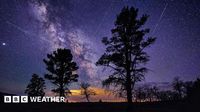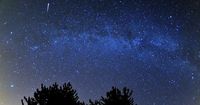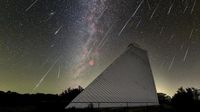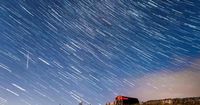The Lyrid meteor shower, one of the oldest known displays of shooting stars, is underway and will peak overnight on Monday-Tuesday, April 21-22, 2025, with about 18 meteors per hour expected, including some super-bright fireballs. This annual celestial event, which occurs every year from mid to late April, offers stargazers a chance to witness short-lived streaks of light in the night sky.
This year, the Lyrids are active until April 25, with the best viewing time anticipated in the early hours of Tuesday morning, April 22. According to the American Meteor Society, the peak is expected around 13:00 UTC on April 22, which corresponds to 08:00 a.m. EDT. The early hours after midnight are the darkest, making them ideal for viewing.
The Lyrids are particularly noteworthy not just for their historical significance but also for their brightness. Observations of the Lyrids date back around 2,700 years, making them one of the oldest recorded meteor showers. They are named after the constellation Lyra, where they appear to radiate from, particularly near the bright star Vega.
The meteor shower is caused by debris from the comet C/1861 G1 Thatcher, which takes over 400 years to orbit the Sun. Discovered in 1861 by A.E. Thatcher, this comet is a key contributor to the Lyrids, releasing small particles that vaporize upon entering Earth's atmosphere, resulting in bright streaks of light.
Although the Lyrids typically produce around 18 meteors per hour, there have been years when the shower has surprised observers with bursts of up to 100 meteors per hour. Dr. Nick Moskovitz, an expert astronomer at Lowell Observatory, noted, “About 10 years ago, the Lyrids had an unexpected outburst. Nobody saw it coming, and we saw over 100 meteors per hour.” This unpredictability adds to the excitement for stargazers.
For those hoping to catch a glimpse of the meteor shower, the best viewing conditions will be in areas away from city lights and light pollution. Stargazers are advised to give their eyes about 15-20 minutes to adjust to the darkness to fully appreciate the display. NASA recommends viewing the meteors after about 10:30 p.m. local time until dawn, with the best viewing around 5 a.m. on April 22.
This year's Lyrids coincide with the Moon's last quarter, which should provide good viewing conditions overall. The Moon will rise around 3:30 a.m. local time on April 22, but at only 27% full, it should not interfere too much with the meteor watching experience.
In the UK, meteorologists predict a mixed bag of weather leading up to the peak night. Low pressure systems are expected to bring cloud and rain to many areas, potentially obscuring views at times. However, clearer skies are anticipated in the east, offering the best chance for stargazers. Edinburgh residents, for instance, may need to travel to areas with less cloud cover to fully experience the shower.
As always, patience is key. Stargazers are encouraged to prepare for a wait, perhaps bringing along a blanket or sleeping bag for comfort. The meteors can be seen without any special equipment, making this event accessible to anyone with a clear view of the sky.
Furthermore, the meteors are not just a beautiful spectacle; they also provide a glimpse into the cosmic debris that travels through our solar system. Scientists estimate that about 48.5 tons (44,000 kilograms) of meteoritic material falls on Earth each day, most of which vaporizes in the atmosphere, creating the dazzling displays we see as shooting stars.
The Lyrid meteor shower is a reminder of the wonders of our universe and the ongoing cosmic events that captivate humanity. With the upcoming peak, stargazers are encouraged to look up and enjoy this celestial show, whether from their backyards or at designated stargazing spots.
As we anticipate the peak of the Lyrid meteor shower, it's a fitting time to reflect on the beauty and mystery of our night sky. The Lyrids not only connect us to the ancient observations of our ancestors but also inspire a sense of wonder about the cosmos that continues to intrigue scientists and enthusiasts alike.
So, gather your friends, prepare your blankets, and head out to witness one of nature's most enchanting displays. The Lyrid meteor shower is a cosmic event that beckons us all to pause and appreciate the beauty of the universe above.








